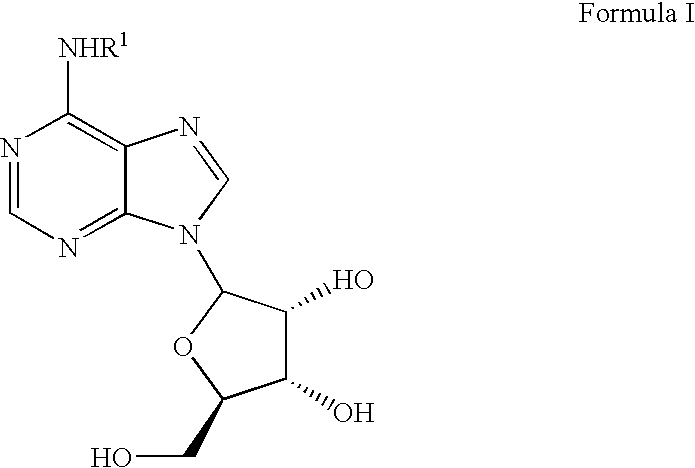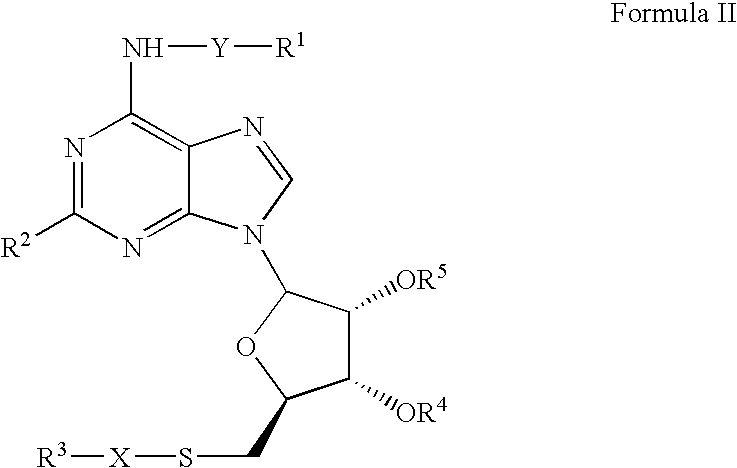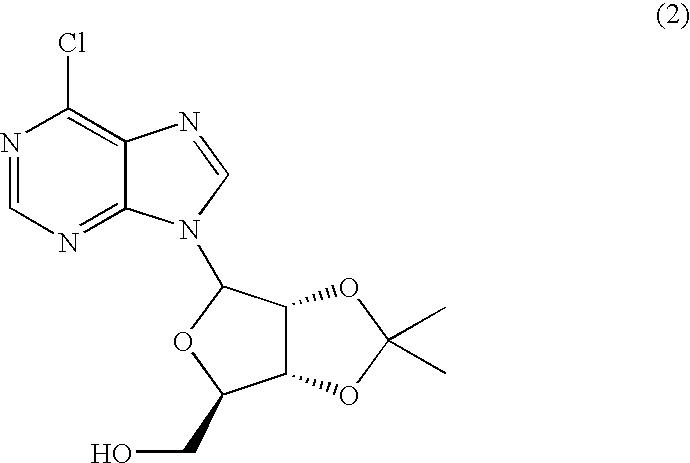Method for treating arrhythmias
a technology for arrhythmias and treatment methods, applied in the field of treatment methods for arrhythmias, can solve the problems of limiting the utility of the compound, all of the above classes have significant limitations, and undesirable side effects
- Summary
- Abstract
- Description
- Claims
- Application Information
AI Technical Summary
Problems solved by technology
Method used
Image
Examples
example 1
[0133] A. Preparation of (3-(S)-aminotetrahydrofuranyl)purine Riboside
[0134] Step 1. Resolution of 3-(S)-aminotetrahydrofuran
[0135] A mixture of 3-aminotetrahydrofuran hydrochloride (0.5 GM, 4 mmol) and (S)-(+)-10-camphorsulfonyl chloride (1.1 gm, 4.4 mmol) in pyridine (10 ml) was stirred for 4 hours at room temperature and then concentrated. The residue was dissolved in ethyl acetate and washed with 0.5N hydrochloric acid, followed by sodium bicarbonate and then brine. The organic layer was dried over magnesium sulfate, filtered, and solvent removed from the filtrate under reduced pressure to provide 1.17 g of a brown oil, which was chromatographed on silica gel (25% to 70% ethyl acetate / hexanes). The white solid obtained was repeatedly recrystallized from acetone to yield the (S)-camphorsulfonate of 3-(S)-aminotetrahydrofu-ran.
[0136] Step 2. Preparation of 3-(S)-aminotetrahydrofuran Hydrochloride
[0137] The (S)-camphorsulfonate of. 3-(S)-aminotetrahydrofuran (170 mg, 0.56 mmol) was...
example 2
[0145] Preparation of 6-(6-Chloropurine-9-yl)-2,2-dimethyltetrahydrofuro[3-,4-d][1,3dioxol-4-yl]Methanol 3
[0146] To a solution of 2-(6-chloropurin-9-yl)-5-hydroxymethyltetrahydrofu-ran-3,4-diol (a compound of formula (1)) (4.9 g, 17.1 mmol) and 2,2-dimethoxypropane (10.5 mL, 84.7 mmol) in dimethylformamide (100 mL) was added p-toluenesulfonic acid (325 mg, 1.71 mmol). After stirring for 24 hours at 70.degree. C., the reaction was concentrated in vacuo and the residue purified by flash column chromatography (70%EtOAc / Hexanes) to give 6-(6-chloropurine-9-yl)-2,2-dimethyltetrahydrofuro[3,4-d][1,3]dioxol--4-yl]methanol, a compound of formula (2), as an off-white solid (2). (3.8 g, 68%) .sup.1H NMR (CDCl3) .delta. 1.4 (s, 3H), 1.65 (s, 3H), 3.8-4.0 (dd, 2H), 4.6 (s, 1H), 5.1-5.3(m, 2H), 6.0(d, 1H), 8.25(s, 1H), 8.8(s, 1H).
example 3
[0147] Preparation of 1-{[(2S,1R,4R,5R)-4-(6-chloropurin-9-yl)-7,7-dimethy-l-3,6,8-trioxabicyclo[3.3.0]oct-2-yl]methylthio}-2-fluorobenzene 4
[0148] To a solution of 6-(6-chloropurine-9-yl)-2,2-dimethyltetrahydrofuro-[3,4-d][1,3]dioxol-4-yl]methanol, a compound of formula (2) (0.48 g, 1.47 mmoles) in 20 mL of tetrahydrofuran was added triphenylphosphine (0.77 g, 2.94 mmoles) and diethylazodicarboxylate (0.47 mL, 2.94 mmoles), and the mixture stirred for 5 minutes. 2-Fluorothiophenol (0.31 mL, 2.94 mmoles) was then added, and the mixture was stirred under reflux. After 72 hours of reflux, the reaction was concentrated in vacuo and the residue purified by flash column chromatography (20%EtOAc / Hexanes) to give 1-{[(2S,1R,4R,5R)-4-(6-chloropurin-9-yl)-7,7-dimethyl-3,6,8-trioxabicyclo-[3.3.0]oct-2-yl]methylthio}-2-fluorobenzene, a compound of formula (3), as a clear viscous oil (3). (0.25 g, .about.40%) .sup.1H NMR (CDCl3) .delta. 1.4 (s, 3H), 1.6 (s, 3H), 3.2 (m, 2H), 4.6 (t, 1H), 5.1 (m...
PUM
| Property | Measurement | Unit |
|---|---|---|
| volume | aaaaa | aaaaa |
| volume | aaaaa | aaaaa |
| covalent bond | aaaaa | aaaaa |
Abstract
Description
Claims
Application Information
 Login to View More
Login to View More - R&D
- Intellectual Property
- Life Sciences
- Materials
- Tech Scout
- Unparalleled Data Quality
- Higher Quality Content
- 60% Fewer Hallucinations
Browse by: Latest US Patents, China's latest patents, Technical Efficacy Thesaurus, Application Domain, Technology Topic, Popular Technical Reports.
© 2025 PatSnap. All rights reserved.Legal|Privacy policy|Modern Slavery Act Transparency Statement|Sitemap|About US| Contact US: help@patsnap.com



